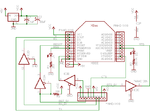konnichiwa_ichigo
Newbie level 2

I'm totally new to electronics, so forgive me if this is some obviously silly question. I have purchased an XBee adapter which has a 5 to 3.3V voltage regulator for voltage input. Does this mean I can provide voltage anywhere between 3.3 to 5V? Or must I provide a 5V voltage? (e.g. Can I provide a 4.5V voltage tot he adapter with three 1.5V battery?
The data sheet for the XBee adapter can be found here:
**broken link removed**
The data sheet for the XBee adapter can be found here:
**broken link removed**


